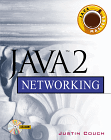Great Workgroup Application Development Guide
Good networking coverage and a unique look at the Java Shared Data Toolkit, but JMAPI hype on the cover is a lie.
ORIGINAL DRAFT
This books is a recent revision and update to the Java 2 platform from an already reasonable networking book. New topics include, great new coverage of the Java Shared Data Toolkit (JSDT), which alone make this book an interesting and valuable read if you’re currently developing or planning to develop distributed workgroup applications. Unfortunately, the marketing department seems to have gotten a little ahead of themselves on this one. The back cover suggests that the book covers the JMAPI (Java Management API) but there is never a mention anywhere in the book, a reminder that it’s good not to judge a book by its cover.
The basic network coverage is straight forward, moving from an introduction to basic IP concepts, the java.net package and touching on related threading issues in the first 4 chapters. Chapter 5 digs into basic TCP applications, the most common approach to Java networking. UDP opens up other possibilities, including fast transfer of small elements, multicast and broadcast solutions, and is covered in chapter 6, which provides good coverage but remains limited in several minor ways. Object serialization allows Java objects to be transferred and RMI allows object methods to be called across the wire. These topics are covered in chapters 6 and 7.
Some slightly more challenging applications are explored in chapter 9 which presents a few advanced RMI concepts and chapter 10 covers content and protocol handers. To me, some of the most interesting material in this book was in the last few chapters, looking at the Java Shared Data Toolkit, which provides an infrastructure for supporting scalable, multi-user applications on the network. It’s clear that the author has experience working with this API and the examples presented are both instructive and revealing, covered across chapters 11, 12 and 13.
If you’re intimately familiar with Java networking concepts, this book may only offer you value if you are interested in the JSDT product (which Sun sells for $99 but can be used freely with a 5 connection limit for evaluation and development). If Java networking is new to you, this is a good buy. The coverage is lucid and logical and the book holds together pretty nicely. This is not necessarily the best book on Java networking, but its focus is clear and the material is likely to be valuable to many readers. Overall, a pretty reasonable investment, especially valuable to those who want to work with JSDT.
